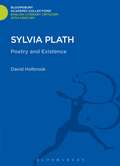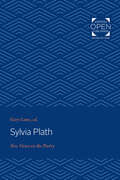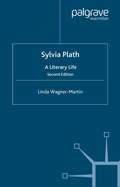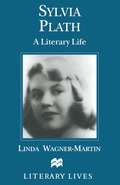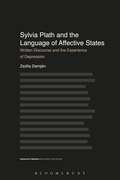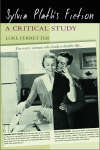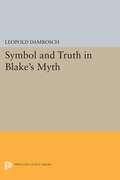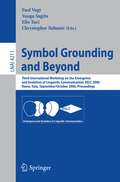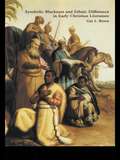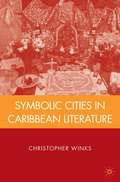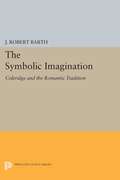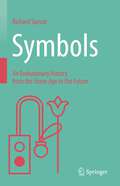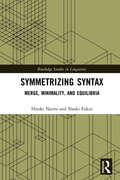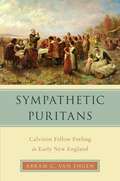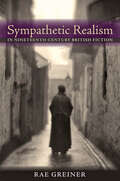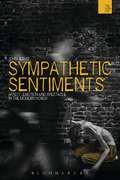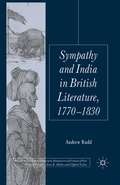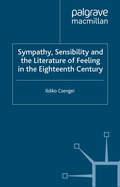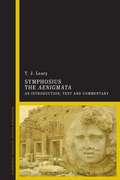- Table View
- List View
Sylvia Plath: Poetry and Existence (Bloomsbury Academic Collections: English Literary Criticism)
by David HolbrookAdmirers of the work of Sylvia Plath will welcome this new paperback edition of a study, first published by The Athlone Press in 1976, which provides coherent and persuasive readings of her poetry. Drawing upon the traditional skills of the literary critic, David Holbrook also deploys the illumination of both psychoanalysis and phenomenology in a pioneering work of literary, individual and cultural interpretation.
Sylvia Plath: New Views on the Poetry
by Gary LaneOriginally published in 1979. Sylvia Plath is one of the most controversial poets of our time. For some readers, she is the symbol of women oppressed. For others, she is the triumphant victim of her own intensity—the poet pursuing sensation to the ultimate uncertainty, death. For still others, she is a doomed innocent whose sensibilities were too acute for the coarseness of our world. The new essays of this edited collection (with a single exception, all were written for this book) broaden the perspective of Plath criticism by going beyond the images of Plath as a cult figure to discuss Plath the poet. The contributors—among them Calvin Bedient, Hugh Kenner, J. D. O'Hara, and Marjorie Perloff—draw on material that most previous commentators lacked: a substantial body of Plath's poetry and prose, a moderately detailed biographical record, and an important selection of the poet's correspondence. The result is an important and provocative volume, one in which major critics offer an abundance of insights into the poet's mind and creative process. It offers insightful and original readings of many poems—some, like "Berck-Plage," scarcely mentioned in previous criticism—and fosters new understandings of such matters as Plath's comedy, the development of her poetic voice, and her relation to poetic traditions. The serious reader, whatever his or her initial opinion of Sylvia Plath, is sure to find that opinion challenged, changed, or deepened. These essays offer insights into a violently interesting poet, one who despite, or perhaps because of, her suicide at age thirty continues to fascinate and trouble us.
Sylvia Plath: A Literary Life (Literary Lives)
by L. Wagner-MartinSylvia Plath: A Literary Life examines the way Plath made herself into a writer. Close analysis of Plath's reading and apprenticeship writing both in fiction and poetry sheds considerable light on Plath's work in the late 1960s. In this updated edition there will be discussion of the aftermath of Plath's death including the publication of her Collected Poems edited by Ted Hughes which won the Pulitzer Prize for Poetry in 1982. Biographies of Plath will be examined along with the publication of Hughes's Birthday Letters . A chronology maps out key events and publications both in Plath's lifetime and posthumously.
Sylvia Plath: A Literary Life (Literary Lives)
by Linda Wagner-MartinLinda Wagner-Martin's emphasis in this study is the way Sylvia Plath made herself into a writer. In keeping with the critic's early ground-breaking work on American poet William Carlos Williams, she here studies elements of Plath's work with dedication to discussions of style and effect. Her close analysis of Plath's reading and her apprenticeship writing both in fiction and poetry sheds considerable light into Plath's work in the late 1960s. The book concludes with a section assessing Sylvia Plath's current standing.
Sylvia Plath and the Language of Affective States: Written Discourse and the Experience of Depression (Advances in Stylistics)
by Zsofia DemjenFocusing on the first journal in The Unabridged Journals of Sylvia Plath, this book writes a convincing case for the value of corpus-based stylistics and narrative psychology in the analysis of representations of the experience of affective states.Situated at the intersection between language study, psychology and healthcare, this study of the personal writing of a poet and novelist showcases a cutting-edge combination of quantitative and qualitative approaches, including metaphor analysis, corpus methods, and second person narration. Techniques that systematically account for representations of experiences of affective states, such as those in this book, are rare and crucial in improving understanding of these experiences. The findings and methods of this book therefore potentially have bearing on the study, diagnosis and treatment of depression and other mental illnesses. Zsófia Demjén follows the cognitive turn in both literary studies and linguistics here, emerging with a greater understanding of Plath, her diarized output and her experience of her inner world.
Sylvia Plath and the Language of Affective States: Written Discourse and the Experience of Depression (Advances in Stylistics)
by Zsofia DemjenFocusing on the first journal in The Unabridged Journals of Sylvia Plath, this book writes a convincing case for the value of corpus-based stylistics and narrative psychology in the analysis of representations of the experience of affective states.Situated at the intersection between language study, psychology and healthcare, this study of the personal writing of a poet and novelist showcases a cutting-edge combination of quantitative and qualitative approaches, including metaphor analysis, corpus methods, and second person narration. Techniques that systematically account for representations of experiences of affective states, such as those in this book, are rare and crucial in improving understanding of these experiences. The findings and methods of this book therefore potentially have bearing on the study, diagnosis and treatment of depression and other mental illnesses. Zsófia Demjén follows the cognitive turn in both literary studies and linguistics here, emerging with a greater understanding of Plath, her diarized output and her experience of her inner world.
Sylvia Plath's Fiction: A Critical Study (Edinburgh University Press)
by Luke FerretterThe first study devoted to Sylvia Plath's fiction covering The Bell Jar and all of her published and unpublished short stories drawing extensively on archival material.
Symbol and Truth in Blake's Myth
by Leopold Damrosch Jr.In a controversial examination of the conceptual bases of Blake's myth, Leopold Damrosch argues that his poems contain fundamental contradictions, but that this fact docs not imply philosophical or artistic failure.Originally published in 1981.The Princeton Legacy Library uses the latest print-on-demand technology to again make available previously out-of-print books from the distinguished backlist of Princeton University Press. These editions preserve the original texts of these important books while presenting them in durable paperback and hardcover editions. The goal of the Princeton Legacy Library is to vastly increase access to the rich scholarly heritage found in the thousands of books published by Princeton University Press since its founding in 1905.
Symbol Grounding and Beyond: Third International Workshop on the Emergence and Evolution of Linguistic Communications, EELC 2006, Rome, Italy, September 30-October 1, 2006, Proceedings (Lecture Notes in Computer Science #4211)
by Paul Vogt Yuuya Sugita Elio Tuci Chrystopher NehanivThis book constitutes the refereed proceedings of the Third International Workshop on the Emergence and Evolution of Linguistic Communication, EELC 2006. The book presents 12 revised full papers together with 5 invited papers. These focus on the evolution and emergence of language - a fast growing interdisciplinary research area touching such different disciplines as anthropology, linguistics, psychology, primatology, neuroscience, cognitive science and computer science.
Symbolic Blackness and Ethnic Difference in Early Christian Literature: BLACKENED BY THEIR SINS: Early Christian Ethno-Political Rhetorics about Egyptians, Ethiopians, Blacks and Blackness
by Gay L ByronHow were early Christians influenced by contemporary assumptions about ethnic and colour differences?Why were early Christian writers so attracted to the subject of Blacks, Egyptians, and Ethiopians?Looking at the neglected issue of race brings valuable new perspectives to the study of the ancient world; now Gay Byron's exciting work is the first to survey and theorise Blacks, Egyptians and Ethiopians in Christian antiquity.By combining innovative theory and methodology with a detailed survey of early Christian writings, Byron shows how perceptions about ethnic and color differences influenced the discursive strategies of ancient Christian authors. She demonstrates convincingly that, in spite of the contention that Christianity was to extend to all peoples, certain groups of Christians were marginalized and rendered invisible and silent.Original and pioneering, this book will inspire discussion at every level, encouraging a broader and more sophisticated understanding of early Christianity for scholars and students alike.
Symbolic Blackness and Ethnic Difference in Early Christian Literature: BLACKENED BY THEIR SINS: Early Christian Ethno-Political Rhetorics about Egyptians, Ethiopians, Blacks and Blackness
by Gay L ByronHow were early Christians influenced by contemporary assumptions about ethnic and colour differences?Why were early Christian writers so attracted to the subject of Blacks, Egyptians, and Ethiopians?Looking at the neglected issue of race brings valuable new perspectives to the study of the ancient world; now Gay Byron's exciting work is the first to survey and theorise Blacks, Egyptians and Ethiopians in Christian antiquity.By combining innovative theory and methodology with a detailed survey of early Christian writings, Byron shows how perceptions about ethnic and color differences influenced the discursive strategies of ancient Christian authors. She demonstrates convincingly that, in spite of the contention that Christianity was to extend to all peoples, certain groups of Christians were marginalized and rendered invisible and silent.Original and pioneering, this book will inspire discussion at every level, encouraging a broader and more sophisticated understanding of early Christianity for scholars and students alike.
Symbolic Cities in Caribbean Literature
by C. WinksUtilizing cross-cultural strands, this comparative study analyzes Caribbean literary representations of magic and invisible cities reworking the notion of the city as both instituted social space and imaginary community.
The Symbolic Imagination: Coleridge and the Romantic Tradition
by J. Robert BarthStudying the nature of symbol in Coleridge's work, Father Barth shows that it is central to Coleridge's intellectual endeavor in poetry and criticism as well as in philosophy and theology. He finds symbol to be an essentially religious reality for Coleridge, one that partakes of the nature of a sacrament, especially sacrament as an encounter between material and spiritual reality. Father Barth notes that eighteenth-century poetry was by and large a poetry of metaphor rather than of symbol, a poetry of reference rather than of encounter. In close readings of the poetry of Wordsworth and Coleridge, he shows how they practiced and developed the poetry of symbol. Finally, analyzing the symbolic imagination, the author concludes that it is a phenomenon profoundly linked with the experience of Romanticism itself and with a fundamental change in religious sensibility.Originally published in 1977.The Princeton Legacy Library uses the latest print-on-demand technology to again make available previously out-of-print books from the distinguished backlist of Princeton University Press. These editions preserve the original texts of these important books while presenting them in durable paperback and hardcover editions. The goal of the Princeton Legacy Library is to vastly increase access to the rich scholarly heritage found in the thousands of books published by Princeton University Press since its founding in 1905.
Symbols: An Evolutionary History from the Stone Age to the Future
by Richard SproatFor millennia humans have used visible marks to communicate information. Modern examples of conventional graphical symbols include written language, and non-linguistic symbol systems such as mathematical symbology or traffic signs. The latter kinds of symbols convey information without reference to language. This book presents the first systematic study of graphical symbol systems, including a history of graphical symbols from the Paleolithic onwards, a taxonomy of non-linguistic systems – systems that are not tied to spoken language – and a survey of more than 25 such systems. One important feature of many non-linguistic systems is that, as in written language, symbols may be combined into complex “messages” if the information the system represents is itself complex. To illustrate, the author presents an in-depth comparison of two systems that had very similar functions, but very different structure: European heraldry and Japanese kamon. Writing first appeared in Mesopotamia about 5,000 years ago and is believed to have evolved from a previous non-linguistic accounting system. The exact mechanism is unknown, but crucial was the discovery that symbols can represent the sounds of words, not just the meanings. The book presents a novel neurologically-inspired hypothesis that writing evolved in an institutional context in which symbols were “dictated”, thus driving an association between symbol and sound, and provides a computational simulation to support this hypothesis. The author further discusses some common fallacies about writing and non-linguistic systems, and how these relate to widely cited claims about statistical “evidence” for one or another system being writing. The book ends with some thoughts about the future of graphical symbol systems. The intended audience includes students, researchers, lecturers, professionals and scientists from fields like Natural Language Processing, Machine Learning, Archaeology and Semiotics, as well as general readers interested in language and/or writing systems and symbol systems.
Symmetrizing Syntax: Merge, Minimality, and Equilibria (Routledge Studies in Linguistics)
by Hiroki Narita Naoki FukuiSymmetrizing Syntax seeks to establish a minimal and natural characterization of the structure of human language (syntax), simplifying many facets of it that have been redundantly or asymmetrically formulated. Virtually all past theories of natural language syntax, from the traditional X-bar theory to the contemporary system of Merge and labeling, stipulate that every phrase structure is "asymmetrically" organized, so that one of its elements is always marked as primary/dominant over the others, or each and every phrase is labeled by a designated lexical element. The two authors call this traditional stipulation into question and hypothesize, instead, that linguistic derivations are essentially driven by the need to reduce asymmetry and generate symmetric structures. Various linguistic notions such as Merge, cyclic derivation by phase, feature-checking, morphological agreement, labeling, movement, and criterial freezing, as well as parametric differences among languages like English and Japanese, and so on, are all shown to follow from a particular notion of structural symmetry. These results constitute novel support for the contemporary thesis that human language is essentially an instance of a physical/biological object, and its design is governed by the laws of nature, at the core of which lies the fundamental principle of symmetry. Providing insights into new technical concepts in syntax, the volume is written for academics in linguistics but will also be accessible to linguistics students seeking an introduction to syntax.
Symmetrizing Syntax: Merge, Minimality, and Equilibria (Routledge Studies in Linguistics)
by Hiroki Narita Naoki FukuiSymmetrizing Syntax seeks to establish a minimal and natural characterization of the structure of human language (syntax), simplifying many facets of it that have been redundantly or asymmetrically formulated. Virtually all past theories of natural language syntax, from the traditional X-bar theory to the contemporary system of Merge and labeling, stipulate that every phrase structure is "asymmetrically" organized, so that one of its elements is always marked as primary/dominant over the others, or each and every phrase is labeled by a designated lexical element. The two authors call this traditional stipulation into question and hypothesize, instead, that linguistic derivations are essentially driven by the need to reduce asymmetry and generate symmetric structures. Various linguistic notions such as Merge, cyclic derivation by phase, feature-checking, morphological agreement, labeling, movement, and criterial freezing, as well as parametric differences among languages like English and Japanese, and so on, are all shown to follow from a particular notion of structural symmetry. These results constitute novel support for the contemporary thesis that human language is essentially an instance of a physical/biological object, and its design is governed by the laws of nature, at the core of which lies the fundamental principle of symmetry. Providing insights into new technical concepts in syntax, the volume is written for academics in linguistics but will also be accessible to linguistics students seeking an introduction to syntax.
Sympathetic Puritans: Calvinist Fellow Feeling in Early New England (Religion in America)
by Abram Van EngenRevising dominant accounts of Puritanism and challenging the literary history of sentimentalism, Sympathetic Puritans argues that a Calvinist theology of sympathy shaped the politics, religion, rhetoric, and literature of early New England. Scholars have often understood and presented sentimentalism as a direct challenge to stern and stoic Puritan forebears; the standard history traces a cult of sensibility back to moral sense philosophy and the Scottish Enlightenment, not Puritan New England. Abram C. Van Engen has unearthed pervasive evidence of sympathy in a large archive of Puritan sermons, treatises, tracts, poems, journals, histories, and captivity narratives. He demonstrates how two types of sympathy -- the active command to fellow-feel (a duty), as well as the passive sign that could indicate salvation (a discovery) -- permeated Puritan society and came to define the very boundaries of English culture, affecting conceptions of community, relations with Native Americans, and the development of American literature. Van Engen re-examines the Antinomian Controversy, conversion narratives, transatlantic relations, Puritan missions, Mary Rowlandson's captivity narrative -- and Puritan culture more generally -- through the lens of sympathy. Demonstrating and explicating a Calvinist theology of sympathy in seventeenth-century New England, the book reveals the religious history of a concept that has previously been associated with more secular roots.
Sympathetic Puritans: Calvinist Fellow Feeling in Early New England (Religion in America)
by Abram Van EngenRevising dominant accounts of Puritanism and challenging the literary history of sentimentalism, Sympathetic Puritans argues that a Calvinist theology of sympathy shaped the politics, religion, rhetoric, and literature of early New England. Scholars have often understood and presented sentimentalism as a direct challenge to stern and stoic Puritan forebears; the standard history traces a cult of sensibility back to moral sense philosophy and the Scottish Enlightenment, not Puritan New England. Abram C. Van Engen has unearthed pervasive evidence of sympathy in a large archive of Puritan sermons, treatises, tracts, poems, journals, histories, and captivity narratives. He demonstrates how two types of sympathy -- the active command to fellow-feel (a duty), as well as the passive sign that could indicate salvation (a discovery) -- permeated Puritan society and came to define the very boundaries of English culture, affecting conceptions of community, relations with Native Americans, and the development of American literature. Van Engen re-examines the Antinomian Controversy, conversion narratives, transatlantic relations, Puritan missions, Mary Rowlandson's captivity narrative -- and Puritan culture more generally -- through the lens of sympathy. Demonstrating and explicating a Calvinist theology of sympathy in seventeenth-century New England, the book reveals the religious history of a concept that has previously been associated with more secular roots.
Sympathetic Realism in Nineteenth-Century British Fiction
by Rae GreinerRae Greiner proposes that sympathy is integral to the form of the classic nineteenth-century realist novel. Following the philosophy of Adam Smith, Greiner argues that sympathy does more than foster emotional identification with others; it is a way of thinking along with them. By abstracting emotions, feelings turn into detached figures of speech that may be shared. Sympathy in this way produces realism; it is the imaginative process through which the real is substantiated.In Sympathetic Realism in Nineteenth-Century British Fiction Greiner shows how this imaginative process of sympathy is written into three novelistic techniques regularly associated with nineteenth-century fiction: metonymy, free indirect discourse, and realist characterization. She explores the work of sentimentalist philosophers David Hume, Adam Smith, and Jeremy Bentham and realist novelists Jane Austen, Charles Dickens, George Eliot, Joseph Conrad, and Henry James.
Sympathetic Realism in Nineteenth-Century British Fiction
by Rae GreinerRae Greiner proposes that sympathy is integral to the form of the classic nineteenth-century realist novel. Following the philosophy of Adam Smith, Greiner argues that sympathy does more than foster emotional identification with others; it is a way of thinking along with them. By abstracting emotions, feelings turn into detached figures of speech that may be shared. Sympathy in this way produces realism; it is the imaginative process through which the real is substantiated.In Sympathetic Realism in Nineteenth-Century British Fiction Greiner shows how this imaginative process of sympathy is written into three novelistic techniques regularly associated with nineteenth-century fiction: metonymy, free indirect discourse, and realist characterization. She explores the work of sentimentalist philosophers David Hume, Adam Smith, and Jeremy Bentham and realist novelists Jane Austen, Charles Dickens, George Eliot, Joseph Conrad, and Henry James.
Sympathetic Sentiments: Affect, Emotion and Spectacle in the Modern World (The WISH List)
by John JervisSympathetic Sentiments develops an innovative interdisciplinary framework to explore the implications of living in a culture of feeling that seems ill at ease with itself, one in which sentiments are frequently denounced for being sentimental and self-indulgent. These tensions are traced back to the inheritance of the eighteenth century, enabling us to identify a distinctive 'spectacle of sympathy', in which sympathy entails public forms of expression whereby being on show is both a condition of the authenticity of such affects and of their capacity to be masked and simulated. This, John Jervis suggests, is at the root of a range of controversies central to modern life, art and culture, including contemporary debates around trauma and compassion fatigue. Connected to these debates is the issue of modern sensationalism, discussed here and elaborated in a companion volume: Sensational Subjects: The Dramatization of Experience in the Modern World, which is published simultaneously by Bloomsbury.
Sympathy and India in British Literature, 1770-1830 (Palgrave Studies in the Enlightenment, Romanticism and Cultures of Print)
by A. RuddIndia was the object of intense sympathetic concern during the Romantic period. But what was the true nature of imaginative engagement with British India? This study explores how a range of authors, from Edmund Burke and Sir William Jones to Robert Southey and Thomas Moore, sought to come to terms with India's strangeness and distance from Britain.
Sympathy, Sensibility and the Literature of Feeling in the Eighteenth Century (Palgrave Studies in the Enlightenment, Romanticism and Cultures of Print)
by I. CsengeiWhat makes it possible for self-interest, cruelty and violence to become part of the benevolent, compassionate ideology of eighteenth-century sensibility? This book explores forms of emotional response, including sympathy, tears, swoons and melancholia through a range of eighteenth-century literary, philosophical and scientific texts.
Symphosius The Aenigmata: An Introduction, Text and Commentary
by T. J. LearyThe post-classical compilation known to modern scholarship as the Latin Anthology contains a collection of a hundred riddles, each consisting of three hexameters and preceded by a lemma. It would seem from the preface to this collection that they were composed extempore at a dinner to celebrate the Roman Saturnalia. The work was to have a defining influence on later collections of riddles; yet its title (probably the Aenigmata) has been debated, and almost nothing is known about its author: questions have even been asked about his name (Symphosius?) and date (4th-5th centuruy AD?).In this edition of the riddles, the Introducion discusses the work's title and its author's identity: as well as his name and date, it considers his national origin (North African?) and intellectual background (a professional grammarian?), and argues that he was not Christian, as has been suggested. It examines the Saturnalian background to the work, setting it in its sociological context, and discusses the author's literary debts – especially to Martial. The Introduction also explores the author's ordering and arrangement of the riddles, discusses his literary style, Latinity and metre, and comments briefly on his Nachleben. It concludes with a survey of the textual tradition. The commentary on each riddle includes a translation, general notes on the object it describes (with reference, as necessary, to museums and artefacts), and discussion of how it fits into the ordering of the collection, of variant readings and, with suitable illustration, of literary, stylistic and metrical considerations. Other areas, such as history and mythology, are also covered where relevant.
Symphosius The Aenigmata: An Introduction, Text and Commentary
by T. J. LearyThe post-classical compilation known to modern scholarship as the Latin Anthology contains a collection of a hundred riddles, each consisting of three hexameters and preceded by a lemma. It would seem from the preface to this collection that they were composed extempore at a dinner to celebrate the Roman Saturnalia. The work was to have a defining influence on later collections of riddles; yet its title (probably the Aenigmata) has been debated, and almost nothing is known about its author: questions have even been asked about his name (Symphosius?) and date (4th-5th centuruy AD?).In this edition of the riddles, the Introducion discusses the work's title and its author's identity: as well as his name and date, it considers his national origin (North African?) and intellectual background (a professional grammarian?), and argues that he was not Christian, as has been suggested. It examines the Saturnalian background to the work, setting it in its sociological context, and discusses the author's literary debts – especially to Martial. The Introduction also explores the author's ordering and arrangement of the riddles, discusses his literary style, Latinity and metre, and comments briefly on his Nachleben. It concludes with a survey of the textual tradition. The commentary on each riddle includes a translation, general notes on the object it describes (with reference, as necessary, to museums and artefacts), and discussion of how it fits into the ordering of the collection, of variant readings and, with suitable illustration, of literary, stylistic and metrical considerations. Other areas, such as history and mythology, are also covered where relevant.
